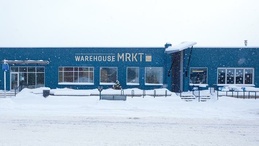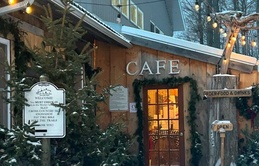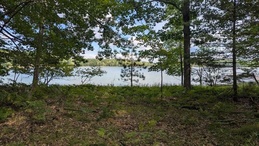A museum grows in Harbor Springs
March 8, 2009
A museum grows in Harbor SpringsKristi Kates 3/23/09
For years, the old Harbor Springs City Hall on Main Street - an imposing and architecturally intriguing historical building that was somewhat incongruously covered in yellow stucco - stood vacant, after the City of Harbor Springs had moved their offices to a new location on Zoll Street. It was once a grand structure, one of the largest and tallest in the Harbor Springs downtown area - so it was a natural choice when the Harbor Springs Area Historical Society (HSAHS) decided to embark on a “Museum Grows” project to restore a local building and turn it into what would be the Harbor Springs History Museum
“Since its inception in 1990, the HSAHS’s mission has been to preserve this area’s history for future generations,” Dave Harrell explains. Harrell, the museum’s Executive Director, helped spearhead the mission to revitalize the building (“a building of tremendous history,” he says) and see the museum opened at last, and the entire HSAHS team, from the board to the staff to the “Capital Campaign” committee, were ready to do their part.
REBUILDING HISTORY
The Victorian-era building was built way back in 1886 as the Emmet County seat, so Harrell and crew knew that it would take a delicate approach to properly renovate the building in order to save its historical value while bringing it up-to-date to meet current codes, and, of course, to house the museum itself. They decided to hire the nationally-recognized architectural firm of Wigen, Tincknell, Meyer and Associates, who specialize in historic preservation projects, and the museum campaign kicked off in 2003.
“The goal of the HSAHS was to open a museum that would serve as the memory of the Harbor Springs area,” Harrell explains, “without professional conservation and preservation, the stories and artifacts detailing the rich and diverse history of the area would be lost forever.”
Not if Harrell and crew had anything to say about it.
After an extensive fundraising campaign, the go was given to begin reconstruction on the old City Hall building, and the construction crews arrived late in the summer of 2007. As the building began its extensive facelift - which at times seemed more like reconstructive surgery - a plethora of accompanying stories began to develop, from the aggrevating to the simply amusing.
In dealing with such an old building, there were bound to be challenges, and the City Hall building offered up plenty of those; the stone foundation of the building was literally crumbling, for one.
“You could just run your hand across it, and chunks of the mortar and bits of stone would fall off,” Harrell remembers, “so we had to take it apart in sections, take the stones outside, clean them off, and then reassemble the whole thing. The basement was pretty scary until they got all of that completed.”
The wooden walls and finishings were hit-and-miss, as well; some of them were in great shape, while other sections were covered in up to a half-inch of paint that had to be removed before the wood could be refinished.
Weather delays, power losses, and even a small fire that started when some overheated equipment was accidentally left next to a pile of sawdust were among the setbacks; but the team persevered, and after 16 long months under construction, the new Harbor Springs History Museum was ready for its opening day on December 5th, 2008.
“Turnout was far greater than we had anticipated,” Harrell says, and the museum has made admission free for the time being (“probably until spring,” Harrell says), as their way of saying “thank you” to the public that supported this massive project.
PRESENTING HARBOR SPRINGS
As for the museum itself, it’s outfitted beautifully with custom cabinets by local firm Creative Millwork, custom exhibits designed by the Good Design Group of Midland, Michigan, and a treasure trove of images and photographs as carefully selected and put together by the museum’s own talented Mary Cummings. The museum does indeed offer a wealth of information on the Harbor Springs area, and many historical details that even locals may not know about; an archives room and study area are under development, so that locals and visitors alike can research even more about the region.
Permanent exhibits on the history of Harbor Springs are currently on display in the Local History and Discovery galleries, and are focused on the development of the community from the migration of the Odawa into the region through the arrival of the missionaries, the fur traders, the logging and shipping industries, resort culture, and right up to the current traditions that make the Harbor Springs community unique.
Along with the gallery exhibits, visitors can get a more interactive take on Northern Michigan through a variety of activities in the Discovery Gallery, including “controlling” a Shay locomotive that runs on a track up above visitors’ heads near the ceiling, and listening in to some old-time telephone calls in which the caller asks the operator to call simply “3” or “9” as opposed to the 526-prefaced 7-digit phone numbers of today.
“Navigating” a ship from Mackinac City to Harbor Springs without “running aground,” is another fun activity - it’s essentially a ship-themed version of the old buzzer game Operation. There are plenty of maps, and fascinating photos of Harbor Springs and its residents in days gone by; and visitors wondering what Harbor Springs residents do in the winter can sit right in an ice-fishing shanty to read about the vintage sport of “Skijoring.”
“Skijoring looked pretty dangerous, actually,” Harrell chuckles, “as you can see in the photo we have on exhibit here, people would line up like waterskiiers on their snow skis, and were holding on to tethers that ran from a car. The car would pull them along, and they’d be ‘skijoring.’ Not exactly safe!”
Another interesting tidbit is how the Knickerbocker Ice Company would cut big blocks of ice from the lake itself, to be used for cooling foods and beverages in the days before buildings had refrigeration.
THAT’S HISTORY
The museum building itself has plenty of character, too; the two small, rectangular brick sections at each end of the building were actually heavy-doored vaults, in which the City Hall would store the monies acquired from property taxes and such, since banks weren’t very well-trusted in the good ol’ days. When Harrell and crew started work on the museum, one of the vaults was already open and accessible - but the other wasn’t. It was locked shut.
“We had a guy come in, just like you see in the movies,” Harrell explains, “he used a stethoscope, and cracked the safe so we could open the door. It was pretty cool.” The doors were moved aside, and set next to the open safe rooms as a display; inside the safes are collections of unusual smaller objects excavated from the museum area.
Upstairs, visitors might notice little clumps of pock marks in the highly-polished wooden floor. Termites? No. Bad wood? Nope - this part of the old city hall was where the policeman of days gone by were trained in how to shoot their guns. Yes, indoors.
“Well, the police in those days needed a place to train,” Harrell explains, “so upstairs it was - the marks in the floor are where the shell casings would fall as they shot at the training targets that were mounted on the wall. They had to stop eventually, though, as some of the bullets were going right through the wall and out into the neighborhood!”
When the craftsman refinishing the museum’s floors was seen simply doing his job by diligently trying to buff these story-filled pock marks out of the wood, Harrell stopped him right away. “I said, no, no, no! What are you doing? That’s history!” he laughed. And so the pock marks remain, where visitors can still view them; albeit under a few layers of glossy museum-approved varnish.
END RESULT
In addition to all of these great historical tales and the permanent exhibits, a series of temporary exhibits, educational programs, special events, and the museum’s own research library should bring visitors back for more.
“We hope to encourage repeat visitation through the year,” Harrell enthused. A new website launched this February allows visitors to check out the special events schedule throughout the year at www.harborspringshistory.org.
Creating the museum may have been a long and arduous process, but for Harrell, the reward is in the result.
“My personal favorite part of the whole process was watching this 120-year old building go through a massive adaptive reuse and restoration,” he says, “the building turned out beautifully, and it was a joy to watch happen.”
The new Harbor Springs History Museum is located right on Main Street in downtown Harbor Springs. Ticket prices will be $5 per adult and $3 per senior (60+) or K-12 student. For more information, call 231-526-9322, or visit the museum’s new website at www.harborspringshistory.org.
Trending

Farm to Glass with Ethanology
When Elk Rapids distillery Ethanology committed to locally-sourced ingredients for their products, it seemed like they&rsquo… Read More >>
MRKT HLDY SHPPNG, aka Warehouse MRKT Holiday Shopping!
Shop the latest from local makers and vendors at the Holiday MRKT Share at Warehouse MRKT in TC, Saturday, Dec. 20, from 10a… Read More >>
Men and Ugly Sweaters
Those two things don’t always go together, but on Dec. 19, you’ll see both out and about in Petoskey and Harbor … Read More >>


